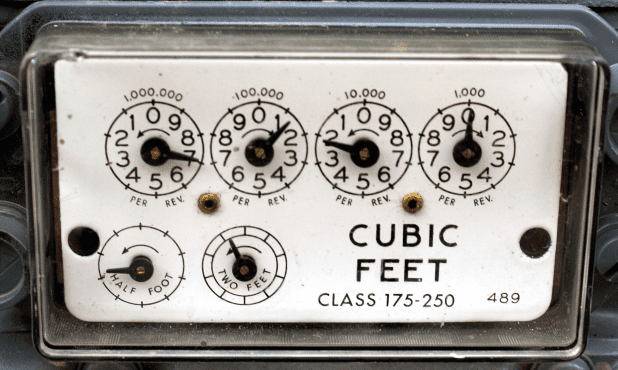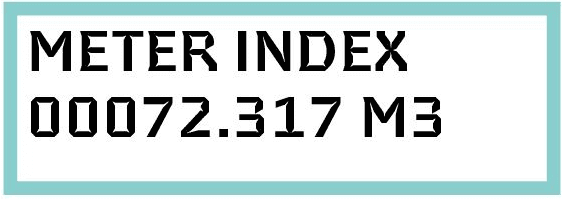Reading your gas or electricity meter
If you know how to read your gas or electricity meter, you’ll be able to check how much energy you have used, and therefore how much you should be paying your energy supplier. This way, you pay for what you’ve actually used, rather than what they think you’ve used.
Even if you have a smart meter that automatically sends readings to your supplier, you may sometimes need to check the meter yourself.
If you don’t have a smart meter, your supplier will send you estimated bills. This might mean that you end up paying for more than you’ve really used. Or you may pay less than you should, in which case you’ll just have to pay the difference later.
Reading your electricity meter
Electricity meters measure in kilowatt hours (kWh) and it will say this after the numbers.
Read the first five numbers, and ignore the red number if your meter has one. The meter below reads 17319.

Reading your Economy 7 meter
If you are on Economy 7 your electricity meter will display two readings. One is for on-peak hours (which could be marked as ‘normal’ or ‘day’) and one is for off-peak hours (‘low’ or ‘night’). On digital displays and pre-payment meters you might have to toggle between two screens, marked Rate 1 and Rate 2 (or R1 and R2).
A red flashing light should indicate whether on-peak or off-peak is currently being recorded by the meter, and allows you to check that on-peak and off-peak hours are being recorded the right way round, or during the correct hours. If in doubt, contact your supplier.
Reading your gas meter
Gas meters measure in cubic metres or cubic feet and your supplier will then convert this to kWh when working out how much you owe. Your bill should explain how they’ve calculated the conversion – see our factsheet ‘Understanding your gas or electricity bill’.
Again read off the numbers, either four or five of them, ignoring any red numbers.
Reading your dial meter
Some old meters – both electricity and gas – have a series of dials, like little clock faces. Here’s how you read them …

The meter above is for electricity, so it has five dials and says ‘Kilowatthours’ underneath the dials.
To read this kind of meter, start with the dial on the left. Write down the number that the pointer has just gone past, in this case 0, then move on to the next dial. Note that some dials in the row turn clockwise while others turn anti-clockwise – so the second dial is 5 as it has not yet reached 6.
The full reading for this dial meter is 05846.
If a point is directly over a number, look at the next dial to the right. If it shows a high number (8 or 9), it means the pointer hasn’t passed the digit that it is hovering above. But if it shows a low number (0 or 1), it has.
Here is an example of a gas meter that shows this.
The first dial shows the pointer right above the number 7. Now look at the second dial. This is 1, so it means that the dial before has passed the 7.
The full reading for this dial meter is 7120.

Reading a smart meter
Millions of UK homes now have smart meters, which means that meter readings are sent to your supplier automatically.
But some older smart meters can’t send automatic meter readings if you switch to a different gas or electricity supplier. This was supposed to be fixed by a wireless update in 2022, but some problems may remain.
This means that you may have to take a reading from a smart meter. In most cases you’ll be able to get the information you need on your energy monitor (also called an ‘in-home display’). This is usually easier than navigating to the correct screen on your smart meter itself.
If you do have to read your smart meter, begin by pressing 9 if your smart meter has a keypad. If you only have an A and B button, press A, and repeat until you reach the correct screen.
On your electricity smart meter, when you reach the correct screen it will flash or include the word IMP or IMPORT, and a number followed by kWh. This is your electricity reading.

On your gas smart meter, the screen will flash or show the word VOLUME or METER INDEX, and a number followed by M3. This is your gas reading.

If you’re unsure, speak to your supplier.
Pre-payment meters
Households with pre-payment meters don’t need to take meter readings to make sure they are billed accurately, but it can still be useful to keep track of your energy use. Your meter will usually have a button that allows you to cycle through various screens, including one telling you how much credit you have left, and one showing your kWh unit and standing charge costs. For an explanation of these, see our prepayment meter webpage, or contact your supplier who’ll send a guide and instructions for your particular meter.
Meter serial number
Your meters will also have their own unique meter serial number. This is the number above the bar code on the picture below. The same number will be written on your energy bills by the meter readings breakdown. You can use the meter serial number to make sure you are matching the right meter to the gas or electricity, or to make sure you are reading your meter and not your neighbour’s.




